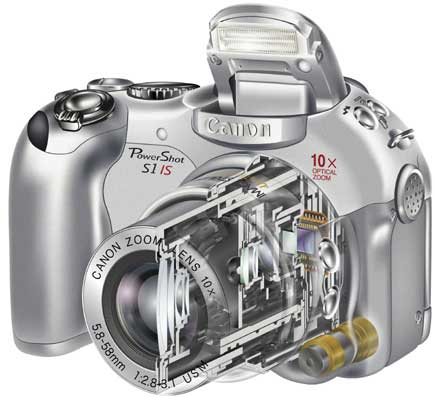Sharpen Your Image With Stabilized Lenses and Digital Cameras
 |
That's exactly what I wondered before testing the first camera with
an image stabilizer. Since then, I have become a convert. Particularly with
telephoto lenses, the system can be incredibly valuable. That's because
any long lens magnifies the least camera shake, increasing the risk of blurry
images. Sure, you could use a tripod instead but most digicam owners would rather
shoot hand-held. And even dedicated photographers find situations where a tripod
is prohibited (as in cathedrals) or impractical: while cycling, backpacking
or shooting from watercraft, for example.
Camera Shake Compensating Devices
An image stabilizing system is useful because none of us can hold a camera perfectly
still. Our natural body tremors create some shake -- upward and downward, and
side to side -- and the effect becomes increasingly visible as we shoot at longer
shutter speeds. The blurring from camera shake may not be noticeable in a small
4x6" snap shot. Make an 8.5x11" glossy however, and the problem
may be obvious; in an 11x15" or larger print, even the slightest evidence
of camera shake will be objectionable.
When shooting with a conventional camera/lens, you can use flash or a high ISO
setting for fast shutter speeds. Both options work can work well in "freezing"
the effect of any camera movement. But there are drawbacks too. Flash is useful
only for nearby subjects and very high ISO settings produce visible digital
noise, colored specks caused by electronic interference.
Canon has offered a solution for owners of EOS SLR cameras since 1998: a series
of IS lenses with a built-in Image Stabilizer. Nikon subsequently introduced
some VR lenses with a Vibration Reduction mechanism and Sigma has released an
80-400mm OS zoom with an optical stabilizer. After extensive testing, I know
that these systems are very effective, great for shooting hand-held when maximum
mobility is required. Problem is, the stabilized lenses range from pricey to
ridiculously expensive and are available only for SLR camera owners.
 |
|
 |
|
|
The first digital cameras with built-in stabilizer were made by Olympus and
Canon a few years ago, but the concept did not catch on until late 2002. That's
when Panasonic released the more affordable Lumix DMC-FZ1 with 12x Leica zoom
and Mega OIS (optical image stabilizer). The camera spawned additional Lumix
models with Mega OIS. It also motivated Canon, Nikon and Konica Minolta to make
some cameras with their own shake compensating mechanism. By the time you read
this, even more brands and models may be available.
How Does Stabilization Work?
In order to appreciate the value of a camera shake compensation system, it's
worth understanding a couple of principles. When a conventional camera/lens
is shaking at the moment of exposure, the image projected to the digital sensor
is also shaking. Hence the photo will be blurred. To minimize the risk when
hand-holding a camera, use a rigid tripod or a fast shutter speed: "one
over the reciprocal of the focal length", according to a rule of thumb.
That means a shutter speed of at least 1/400 sec. at 400mm, 1/250 sec. at 250mm
and 1/30 sec. at a 28mm zoom setting. (All focal lengths are stated in 35mm
equivalents.)
If you want to shoot at longer shutter speeds without a tripod or other firm
support, it's worth considering a stabilized lens or digital camera. Most
of these incorporate an optical stabilizer that works like this. When sensors
detect camera shake, a microcomputer shifts a group of lens elements in the
appropriate direction to counteract the effect. The incoming light rays are
refracted (bent) and the projected image is returned to the center of the frame.
That increases the odds of sharp photos, without noticeable blurring from camera
movement.
Konica Minolta employs an entirely different approach. Some of their DiMAGE
cameras -- and the Maxxum 7D digital SLR -- incorporate an Anti-Shake system
that shifts the entire sensor module to compensate for camera movement. The
Anti-Shake system in the Maxxum 7D offers great versatility: It's effective
with every Maxxum lens ever made with two exceptions: the 16mm Fish Eye and
the 3x -- 1x Macro Zoom. The "CCD-shift" system also works
well with at least some independent brand Maxxum mount lenses; a full list of
those would require testing numerous other lenses.
 |
|
 |
|
|
Stabilizer System Evaluation
Over the past eighteen months I have worked with many of the digital cameras
that include a shake compensating device. Frankly they're just as effective
-- in the most important respect -- as the SLR system lenses with IS, VR or
OS stabilizers. You can find my evaluations of several such lenses at www.shutterbug.com;
use the Search function to look for test reports of Canon, Nikon and Sigma telephotos
and zooms.
Some of lenses with built-in stabilizer provide one significant advantage over
cameras with comparable systems. The recent Canon, Nikon and Sigma telephotos
include a mode for panning at slow shutter speeds in action photography. When
that option is selected, the system compensates only for vertical (up/down)
shake; it does not try to compensate for the intentional horizontal movement.
Pan at just the right speed and the subject should be fairly sharply rendered,
while the background will be streaked -- but smoothly -- for a convincing effect
of motion. By contrast, only one digital camera (DiMAGE Z3) with built-in stabilizer
is optimized for panning. Sure, you can use any of the cameras for the same
purpose, but you won't always be happy with the results.
Note: No optical or mechanical stabilizer can stop the motion of a moving subject.
Hence, a fast shutter speed is required to "freeze" a high jumper
in mid-air or an eagle or motorcycle speeding toward you.
 |
|
 |
|
 |
|
|
In my experience, the various types of cameras and lenses with stabilizer
are roughly equal in their effectiveness. On average, they provide a two to
three shutter speed step advantage over conventional equipment. That's
certainly meaningful because it allows us to shoot at ISO 100 or 200 instead
of ISO 800 in low light, for superior image quality without worrying about the
longer shutter speeds.
Aside from the benefits in low light shooting, any type of stabilizer offers
an advantage in bright to moderately bright light. It allows us to shoot at
small apertures at low ISO settings for extensive depth of field, without worrying
about the longer shutter speeds when hand-holding the camera. The expanded zone
of acceptable sharpness is often valuable in landscape, travel and "macro"
nature photography. Finally, it's great to be able shoot at f/8 or f/11
because most zoom lenses produce the best optical performance when used at those
moderate size apertures.
The Bottom Line
The exact benefit provided by any camera or lens with a shake compensating device
varies, based on several factors. For starters, some people are naturally steadier
than others. When testing the Lumix DMC-FZ20, my colleague Jack Neubart made
razor sharp images at the 432mm focal length at a 1/50 sec. shutter speed. That's
better than the 1/90 sec. shutter speed that I usually needed for critical sharpness,
unless I braced my elbows on some firm support. Naturally, we both made some
fairly sharp images at a long, 1/30 sec. shutter speed as well, but not consistently.
Note too that heavy cameras/lenses (with greater mass) require less stabilization
than their very light/compact counterparts. Hence, we can generally use them
at surprisingly long shutter speed without serious blur from camera shake. Finally,
all stabilizers produce the most impressive benefits at very long focal lengths.
You might get a three shutter speed step advantage at 200mm but only a two step
advantage at the 28mm end of a zoom lens, for example. Of course, as they say,
"your own mileage may vary."
Regardless of the exact technology, any camera shake compensating system pays
dividends. It allows snap shooters to make sharper pics and offers serious photographers
greater leeway in selecting the most appropriate aperture/shutter speed. These
problem-solving aspects are definitely worthwhile, helping to increase our success
ratio of technically excellent images.
 |
|
|
Digital Cameras With Integral Stabilizer
In addition to the many lenses with a built-in stabilizer or vibration
reduction system, an increasing number of digital cameras incorporate a shake-compensating
device. The following were available at the time of writing but we expect additional
models to be announced. (Lens focal lengths are shown in 35mm format equivalent.
Street prices are provided below but these are subject to change.)
 |
|
|
Canon: Like the stabilizer system available in some EF lenses,
the device used in two PowerShot cameras shifts optical elements to compensate
for camera shake.
PowerShot S1 IS: 3 megapixel; 38-380mm f/2.8-3.1 lens; $349
Canon PowerShot S2 IS: 5Mp; 36-432mm lens; $499.
Konica Minolta: All of the following cameras use a unique
Anti-Shake system that shifts the entire CCD sensor module, in any direction,
to compensate for camera movement.
DiMAGE Z5: 35-420mm f/2.8-4.5 APO GT lens; $449.
DiMAGE Z3: 35-420mm f/2.8-4.5 APO GT lens; $389.
DiMAGE A2 and A200: 8Mp; 28-200mm f/2.8-3.5 lens; $749 and
$649, respectively
Maxxum 7D: 6Mp Digital SLR; CCD shift anti-shake device works
with nearly all Maxxum lenses; $1499
 |
Nikon: This company's VR lenses include a stabilizer
that shifts elements to miminze blur from camera shake; similar technology is
used in their CoolPix 8800 camera.
CoolPix 8800: 8Mp; built-in Nikkor 35-350mm lens; $999.
 |
|
|
Panasonic: The following cameras use the Mega OIS optical
stabilizer with two options. Mode 1 provides full time shake compensation that
also helps stabilize the viewfinder image. Mode 2 provides greater effectiveness
but is activated only when the camera's shutter release button is pressed;
the viewfinder image is not stabilized.
Lumix FZ-20: 5Mp; Leica 36-432mm f/2.8 lens; $599.
Lumix FZ-15: 4Mp; Leica 35mm - 420mm f/2.8 lens; $499.
Lumix FZ-5: 5Mp; Leica 36-432mm f/2.8-3.3 lens; $499.
Lumix FZ-4: 4Mp; Leica 35-420mm f/2.8-3.3 lens; $449.
Lumix FX7: 5Mp; Leica 35-105mm lens; $399
Lumix LZ-2: 5Mp; Panasonic 37-222mm f/2.8-4.5 lens; $299.
Lumix LZ1: 4Mp; Panasonic 37-222mm f/2.8-4.5; $249.
Lumix LS1: 4Mp; Panasonic 38-105mm f/2.8-5; $229.
Sony: During the PMA 2005 trade show, Sony announced their
first camera employing an optical image stabilizer. The H1 will be available
in June or July 2005.
Cyber-Shot DSC-H1: 5Mp; Sony 36-432mm f/2.8-3.8 lens; $499.
- Log in or register to post comments












































